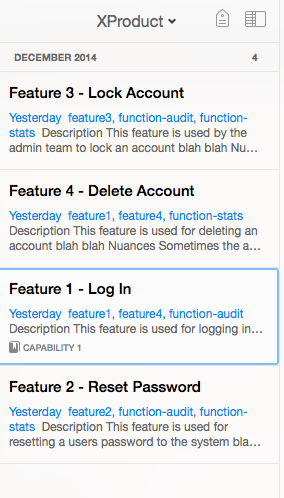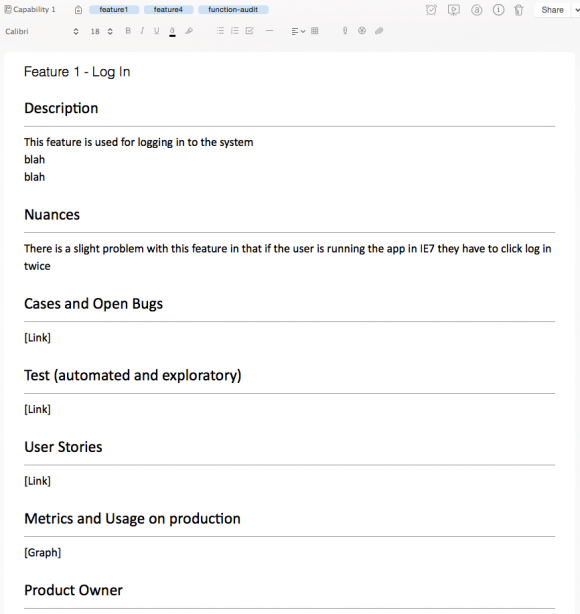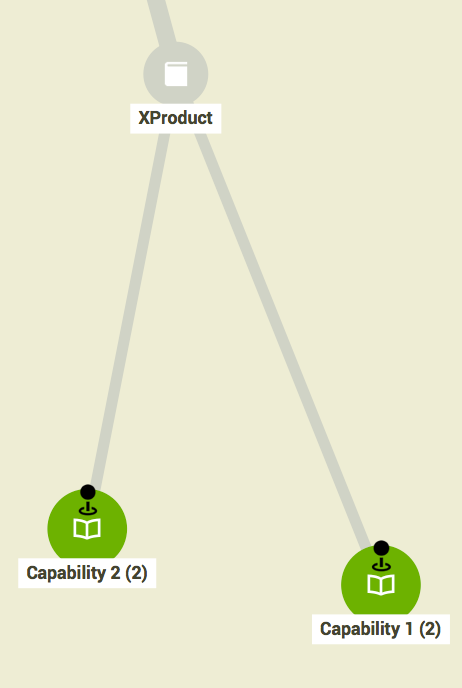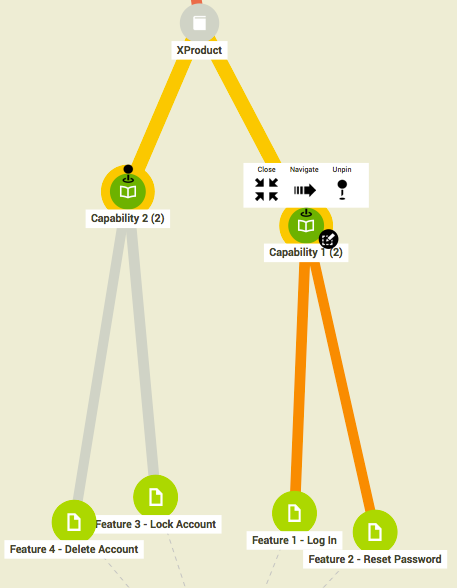One of the perrenial challenges I’ve had at every company I have worked for is being able to see an organic and evolving view of the product being built that isn’t buried deep in the code, or hidden in high level specs that are out of date.
This got me thinking – what if I could use Evernote and MohioMap to visualise the product being built, the links between the components and features and of course, the detail of what each component does.
So I drew out a basic, and I mean basic, challenge of showing the dependencies between components.

In the above there are two main capabilities (activities that the user can do). For example, Capability 1 (C1) could be “accessing the system” – a valuable capability so that the user can use the product or service.
Capability 2 could be “Admin” access to user permissions so that the administrators can manage users.
Within the first capability there are a number of features – things the user can do. For example, they may be able to log in (F1) or reset their password (F2).
In this example both of these features are intrinsically linked to other parts of the product, parts which may not be under development right now.
For example these features may be linked to the stats module and/or the audit trail. For example, when someone logs in an audit is logged (using existing audit features) and when someone resets their password a statistic is generated (using existing stats features). In this example there is also a link between Feature1 and Feature4.
This is very basic, but it demonstrates how a simple set of capabilities could become complicated and how specs end up reproducing, or cross referencing, others parts of the product that may, or may not, be under the remit of a current development work.
Where does Evernote come in?
Well, here’s a rough hack around I’ve been experimenting with.
I started by creating a basic notebook stack. Ignore the “X” part of the project name – I just used that to keep this Evernote stack at the end of my notebook/stack list.

Within the stack I created two Capability Notebooks. (for more on Evernote stacks this video is pretty good)
Within each of the two Capability Notebooks I created two Feature Notes resulting in four notes – Features 1 to 4.
I used a template to create each feature note so that the content headings would all be the same.
Here is the view of the entire stack content hence all four notes showing in one list.

The following image is an example of a feature note, in this example it’s Feature 1 – Log In.
I have included the following example sections :
- Description – space for a detailed description about what the feature does.
- Nuances – a space for people to list observations of how the feature works – sometimes that may not be as expected.
- Cases and Open Bug – a place for links to any cases or open bugs (I suspect this section is the most likely to be out of date quickly)
- Test – a space to add links to any auto test, build, exploratory or other test reporting.
- User Story – a space to store a link to the user story
- Product Owner – a name of who owns this part of the product
Of course – this is just a rough starter for ten – you could include whatever you wanted to.
(I’ll do a post in the future on using services like Zapier and IFTTT to automate and update some of the content here)
For example Zapier could be used to create a new note in Evernote when a new pivotal tracker item is created.

I then added tags to each note.
I added to the feature 1 note the tag “feature1” as this is indeed feature 1. I then tagged it with “feature4” as this feature is indeed associated closely to feature 4.
I also tagged it with “function-audit” as this feature is associated with the audit functionality. Again – the tags could be whatever makes sense in your context. This is just an example.
Where does MohioMap come in?
Glad you asked. This is where MohioMap comes in.
Opening up Mohio and connecting it to Evernote shows your entire evernote as a kind of mind map.

Pretty cool – you can click on the nodes and lines and tags and start zooming around your Evernote landscape. You can see how notes are connected by tags.
So if this was your product you’d be able to see at a high level how everything hangs together. Sure – most systems are more complex than my own Evernote collection but hey – you get the idea.
For this example I’ll find my notebook stack.

I can now click on each Capability note and expand this further.

At this point I have tags turned off from the view in Mohio. Here’s with them turned on.

You can change the amount of detail you see by using the scroll bars for each element.

At any point you can click on the notes and be taken to that very Evernote note in the web version of Evernote.
You can quickly start to see how your product is connected and start to add suitable information to each note.
This hack, like most systems like it, relies on the information, tags and data being up-to-date and correct but by simply using Evernote it’s possible to get both a high and low level view of your product.
In one of my next posts I’ll show how test reporting could be added by simply creating a test notebook and tagging your test notes with suitable tags.
On another point – MohioMap also supports Dropbox and Google Drive meaning you can now see all of that stuff too!
If you want to find out more about Evernote then look no further than Brett Kelly’s awesome Evernote Essentials (affiliate) 
2 thoughts on “Visualising your product or service using Evernote and MohioMap”
Comments are closed.